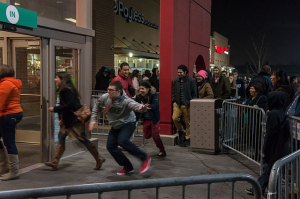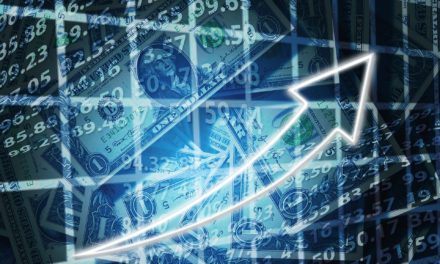
Lining up for Black Friday shopping, courtesy of Powhusku, CC BY-SA 2.0.
It’s the most popular shopping day of the year: the day after Thanksgiving, better known as Black Friday. Companies make huge ad buys in newspapers, cover the airwaves with sales, and open early—sometimes as early as Thanksgiving evening.
For some it’s a tradition: standing outside in the middle of the night, waiting for retail stores to open. The prized purchases include TVs, computers, video game systems, and more. Black Friday has traditionally been known as the start of the Christmas shopping season, and for the last decade it has been the busiest shopping day of the year.
Despite all the publicity of Black Friday, the actual numbers tell a bit of a different story. For starters, retailers cannot use it as a bellwether for how the rest of the holiday season will fare. The idea used to be that a good Black Friday would lead to a strong final month of sales. However, data from 2006 through 2012 reveal a very different story. In 2006, retailers saw a 25% increase in year-over-year sales on Black Friday, but total holiday sales were just 5% higher than the previous year. It was worse in 2008 when Black Friday sales jumped about 20% but holiday sales actually dipped from 2007.
Meanwhile, online sales have been rising since around 2010. Take a look at Amazon and its incredible growth over the last 6 years. In 2010 major retailers brought in around $80 billion, compared to Amazon’s less than $20 billion. Over the next 4 years, retail sales remained stagnant while Amazon continued to increase revenue. This year Amazon’s sales are expected to surpass all the sales by major retailers.

Shopping on Amazon, courtesy of Pixabay.
In the last few years, a new shopping holiday has picked up steam: Cyber Monday. It’s the first day back at work for many Americans after the Thanksgiving holiday, but that doesn’t mean buying takes a back seat. Online retailers as well as brick-and-mortar stores are utilizing the Internet to offer deals that Monday as a way to cash in on workers who may do a little shopping online while at work.
Cyber Monday sales beat analysts’ predictions, with more than $3 billion in total revenue for the day. It was the single biggest day for online sales and the best Cyber Monday since the shopping holiday started a decade ago. Amazon’s revenue on Cyber Monday jumped 21.1% from 2014. Target saw customer orders being recorded at twice the speed of any previous sales day; that led to record sales for the company, which is known as a strong brick-and-mortar retailer as well as a strong online force.
Speaking of retail, Black Friday 2015 was not what retailers had hoped it would be, with sales at $10.4 billion, down from $11.6 billion last year. One reason sales were down was, of course, the online factor that we’ve already mentioned. However, retailers have been putting less focus on Black Friday and instead offering discounts and deals beginning the week before Thanksgiving and lasting all the way through December. The idea is to catch all the different types of shoppers, from the early birds all the way to the procrastinators who buy gifts on Christmas Eve.
One thing is certain: it wasn’t too many years ago that online sales were a supplement. Today, online sales are key for just about every retailer. And with online buying being so powerful, it’s important that companies make sure their websites are optimized for smartphones. This year, customers using smartphones made up more than a third of online buyers.
With Black Friday becoming less important to retailers, it might not be that far in the future when the idea of waiting outside a store late at night is a thing of the past, and customers instead wait on their phones, waiting for the big sales.





Recent Comments